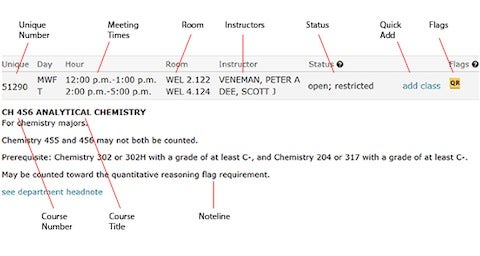The online course schedule provides general information about the University, such as registration procedures, fees and deposits, academic advising requirements, a list of classes containing a significant writing component, an index of final examination times, and grade reporting procedures. Read about these by pressing the links in the navigation bar along the side of any page in the schedule.
The schedule also lets you search for courses. A search will display class listings like the one below. Each class listing has a number of parts.
Most of the Course Schedule is devoted to class listings and associated information. In general, fields of study are arranged alphabetically by college and, within those divisions, alphabetically by department/academic program. Each academic area has a headnote that lists the administrative officers for the area, along with their office addresses and phone numbers. In many cases, important information about course prerequisites, descriptions, and enrollment restrictions is given in the headnote.
Parts of a class listing

- Course numbers.
- These start with the department code made up of one to three letters, and end with a three-digit number. Summer courses have a lowercase letter before the number: f-first term, s-second term, n-nine weeks, w-whole session. In the summer, courses sort after f, s, n and w. Note: Within a department, courses alphabetize by field, and then sort by their last two digits.
- Course titles.
- This is the name of the class following the course number, and apply to all sections below them until a new course appears. For each course number, titles sort alphabetically. Those with topic numbers sort numerically.
- Notelines.
- On the details page you will find information that includes course descriptions, prerequisites, enrollment and other restrictions, and cross-listed courses, and apply to all sections of the course.
- Unique number.
- A five-digit number which identifies a particular section of a course. (This number is required to register). On the results pages, clicking a unique number opens a page with class details.
- Meeting times.
- The days of the week are listed by their initial letters: MTWTHF means a class meets Monday through Friday all semester. When multiple timelines are displayed, it usually indicates that the first timeline is for the lecture, and the second timeline is for the discussion or lab section. There can be up to 3 timelines per unique number and students must attend all listed times. (If it meets on additional days, on certain dates, or for only part of a semester, this will be noted on the details page). Class hours follow the weekday. » Also see meeting time in the glossary.
- Rooms.
- The building, room and floor where the class meets. Buildings are abbreviated with three letters. » Also see the list of buildings and their abbreviations.
- Instructor.
- The person who is teaching the class. If it is blank then the instructor has not been assigned.
- Status.
- The real-time registration status of a course section displays online, and includes classes which are open; restricted to specific majors or students, closed, waitlisted, or canceled.
- Quick add.
- This link takes students directly to the registration system to add the class if it is open and available. This new feature is a result of receiving feedback from students including representatives of the Student Government Association and the Senate of College Councils.
- Flags.
- Skills and Experience Flags may be required to fulfill an undergraduate degree plan’s requirements. Students should refer to their catalog or consult their academic adviser to determine which Flags are required for their major, and to learn about how to earn each Flag in the process of completing the major, core, and other degree requirements.

